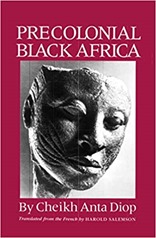I picked up It’s a Continent: Unravelling Africa’s History One Country at a Time by Astrid Madimba and Chinny Ukata at Waterstones, I was looking for books on Africa – preferably written by Africans – this was one of a very limited selection on the shelf.
The authors identify as British-Nigerian and British-Congolese, you can read a bit more about them on their podcast website here. As they say at the beginning of the book, they are not historians and this is not a history text book. They describe it as a collection of stories you never heard at school which I think is fair.
The book comprises short chapters on each of Africa’s 54 countries (and one disputed territory). They focus on one element of the country’s history – varying between pre-colonial history, the colonial period and post-independence. Often they are focused on an individual, typically they are only a few pages long . They are fairly relaxed in style with the odd sarcastic aside. I can imagine they follow the style of the podcast.
Of my recent reading about Africa, An African History of Africa was a sweeping fairly academic chronological history of Africa which was not really tied to individual countries, and covered the independence movements fairly briefly. Africa is Not a Country is a more thematic book which is focussed on the present. As the author’s say, It’s A Continent is the stories of history we hear at school but for Africa rather than for Britain. It has the effect of making the countries of Africa feel more distinct.
One of the recurring themes was how countries gained independence, this is where the many-country coverage helps because common features arise. The world wars, particularly the Second World War produced an expectation of some payback for the lives and resources committed by the colonies to the war on the side of their colonial masters. Secondly, the US/Britain Atlantic Charter of 1941, which envisaged a post-War future, led to the foundation of the UN in 1945 which had self-determination (i.e. independence ) at its core. Furthermore the colonising forces, generally France and Britain, could no longer afford to manage their colonies. Germany had been forced to give up its colonies (centred around Tanzania, Namibia and Cameroon) in the aftermath of the First World War, they were transferred to France and Britain.
The post-independence pathway shows a rather depressing regularity too with independence heroes either turning slowly more and more authoritarian or being rapidly replaced by despots (often from the army, trained and backed from outside the country). Madimba and Ukata reference this in their glossary, referring to a Coloniser Handbook and a Despot Manual.
It’s easy as a Western European to look down on the imperfect democracies of Africa. However, we have our own share of conflicts in Europe. Since World War 2 there have been three dictatorships (Spain, Portugal and Greece) which ended (early) in my lifetime. Yugoslavia and the Soviet Union have broken up fairly violently, Czechoslovakia seems to have managed to split peacefully but this is exceptional. There are a number of secessionist movements in Europe. The US is currently demonstrating how young democracies are not immune to returning to authoritarian rule. To this Africa has the added difficulty of artificial borders created by colonisers, infrastructure designed to extract resources from countries rather than support its residents, deliberate divide and rule policies during the colonial period and post-independence interference either as part of the Cold War or by the pre-independence colonists.
Reading through the chapters there were a couple of surprises, it turns out that Russia briefly had a foothold in Africa via the town of Sagallo in Djibouti which was “acquired” by Nikolay Ivanovich Ashinov in 1885. Ashinov appears to have been a complete con man and Russia quickly lost Sagallo to the French.
I was also surprised to discover that their are two European cities in Morocco, Ceuta and Melilla which are heavily funded by the EU to prevent them becoming an entry point into Europe for African migrants. Unsurprisingly the Moroccans want them back.
One of the nice things about the book is its universal coverage, so as well as the big favourites like Nigeria, Kenya, Egypt and so forth we hear of the small islands – Comoros, Seychelles, São Tomé and Príncipe, Cabo Verde, the Chagos Islands) and countries like Togo.
I was born in the seventies, I became politically aware around 1980 when the first wave of independence movements had passed and the final few were being completed – the formation of Zimbabwe was one of my earliest political memories. Over my lifetime the news stories from Africa have largely been of civil war, dictators and natural disaster (I’m including famine here, though that is rarely wholly natural). Britain largely sees itself as a fairly benevolent colonial power which is reflected in popular culture. Madimba and Ukata have a very different point of view which I believe is probably correct.
I enjoyed this book, to start with I was a bit put off by its casual style but it makes it rather engaging and readable. I am now curious about the foundation of the UN and its role in African independence movements.




